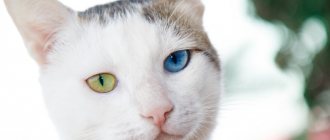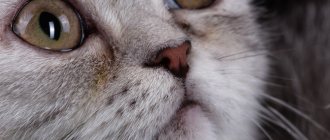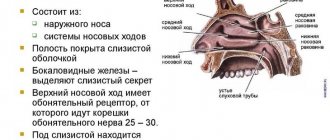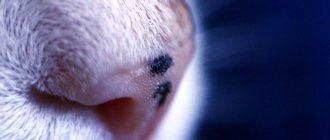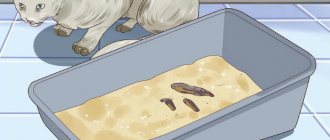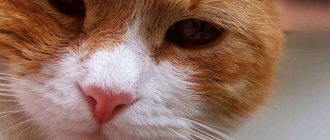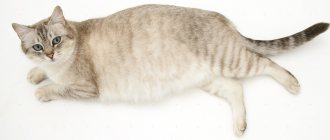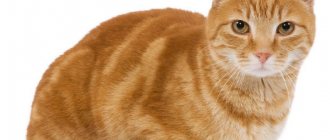- Posted by Olesya Vakhraneva
- Date: September 14, 2018
Just one useful habit, which does not require much effort and time, allows you to contact a veterinarian at the first signs of illness in your cat and not leave it alone with the disease. This is a habit of regularly paying attention to the cat's nose.
- 2 What should a healthy cat’s nose look like?
- 3 Changes in indicators, as evidenced by them
3.1 Dry nose and its causes
- 3.2 Warm or cold: what affects temperature
3.2.1 Photo gallery about nasal discharge in cats:
- 3.3.1 Photo gallery about spots on the nose of cats:
- 3.4.1 Photo gallery about the treatment of narrowing of the nasal passages:
Changing the color and shape of a cat's nose
Photo: painful nose of a cat
It is worth paying attention when the animal’s olfactory organ changes color and shape. If it becomes scaly or changes color, is dry and its skin cracks, or ulcers open, then this is a reason to contact a veterinarian. Among other things, it is important to monitor its color. At different periods of life, this organ brightens and takes on its normal color. And here it is necessary to differentiate the reasons for the color change. After all, it can lighten due to changes in ambient temperature or due to age-related changes, which is natural. But this is also possible due to the deterioration of the cat’s health. A lighter nose indicates a deterioration in the functioning of the circulatory system, diseases of the internal organs, infections, banal wounds or other physical effects. Therefore, painful color changes are necessarily accompanied by other symptoms.
Functions of a cat's nose
The cat's nose has truly amazing properties.
Table: comparative characteristics of the sensitivity of smell
| View | Area of the olfactory epithelium | Number of olfactory receptors | Sensitivity |
| Human | 2–4 cm2 | ~5 million | Sample for comparison |
| Cat | 20 cm2 | ~200 million | 20 times better than a human |
| Dog | 170 cm2 | ~220 million | 50–1000 times better than a human |
Thus, it is clear that a cat’s nose, although weaker than a dog’s, is much more sensitive than a human’s. A cat is able not only to recognize odors hidden from humans, but also to build a complete picture of the surrounding space. Cats, unlike dogs, do not use their sense of smell to search for prey or stalk. She just doesn't need it. But for orientation in space, when communicating with relatives and people, and determining the suitability of food, it uses it with success.
This is why you should not wash your cat's bowls using chemicals. The pet will smell the substance for a very long time, and accordingly, this can lead to refusal of food. You should also be careful when cleaning your cat's litter box. It is enough to wash it with hot water in a timely manner, since high temperature destroys ammonia molecules, and the smell ceases to exist for humans. But not for a cat.
Many owners have learned to determine the quality of meat products by offering them to their cat. The fact is that the animal, carefully sniffing the food offered, easily determines its suitability for consumption. And the sausage, stuffed with preservatives and other “chemicals”, will remain untouched.
Cats love certain smells. Manufacturers know this and flavor their feed. This is what explains the passion of animals for dry food or canned food. And this is why pets so easily switch to this diet and refuse regular food.
Manufacturers of cheap dry food flavor them to make the product attractive to cats.
But the smell of orange or mothballs disgusts pets. These scents are used as repellents in all sorts of products designed to wean a cat off something.
Cats also do not like the smell of garlic and onions. At home, these finely grated vegetables can be placed in plates where the presence of cats is undesirable.
In addition to olfactory functions, a cat's nose is also intended for:
- warming and humidifying inhaled air;
- determining food temperature.
A cat is able to retain molecules of certain aromas in the nasal labyrinth in order to use the smell for its own purposes longer. Kittens use this technique with success. Being blind, they not only find the mother, but also distinguish the cat's nipples.
A newborn kitten finds its mother and her nipples solely by smell
If your cat has a dry and hot nose
This is what a problematic dry nose looks like
If this organ of the animal remains dry and hot for more than 2 hours, then this is a reason to worry about its health. The cat needs to be examined and if it is sick, other symptoms will also appear. A sign of health is a cold nose. However, you shouldn’t relax here either, since a too cold nose along with the appearance of symptoms of the disease is a cause for concern. And it will be useful to measure the cat's temperature, which under normal circumstances should be around 38-39 °C.
Reason to worry
If you notice any ailments, check the symptoms.
- If a cat begins to frequently wash its face with its paws, rubs its nose and eyes, and discharge occurs, there are clear signs of an allergy.
- Ulcers, spots, and crusts appeared on the nose - signs of dermatological diseases.
- Sneezing and a wet, dry nose indicate a cold.
- Hot ears and lips, as well as the color of the nose indicate an increase in temperature. A blue nose indicates hypothermia. Severe pallor indicates anemia and dehydration. Red nose - oxygen starvation, allergies or rhinitis.
- Vomiting and diarrhea indicate a more serious illness - poisoning.
- Apathy, loss of appetite, sleep disturbance indicate the presence of a disease.
First, you should measure the cat's body temperature, but not everyone has a special thermometer for animals, and not everyone is able to measure the temperature. Therefore, when various symptoms appear, veterinarian intervention is required.
The doctor can find possible causes of diseases based on symptoms. Commonly encountered diseases include:
- Rhinitis is a cold.
- Sinusitis.
- Allergic reactions.
- Infections.
- Worms.
- Injuries to the nasal canals and palate.
Also, after castration or sterilization, the pet’s nose may become hot during the day. This reaction is normal, because drugs that are administered to animals as anesthesia block the glands that regulate nasal circulation. In order not to panic, monitor your pet for 24 hours. If the situation does not improve after a couple of days, you should think about it.
Pay attention to the nose and the fur around it.
Nasal discharge in a cat
If your pet has nasal discharge, swelling, or is having trouble breathing, it's time to call your veterinarian. These signs indicate the presence of a foreign body inside, infection or even a tumor. If discharge appears from only one nostril, then it may be a foreign body stuck inside. Other signs of these illnesses include sneezing, nose picking, or bleeding. Nasal polyps or tumors often coincide with bloody discharge or mucus from the inside, the cat's breathing becomes noisy, and a bulge or bump may appear on one side of the face.
Check your cat's nose often
Examination of an animal’s olfactory organ is an obligatory part of home life. Knowing the appearance and shape of a cat's nose when it is healthy makes it easier to determine when disease appears. Examine and look for unusual signs, such as nasal discharge, especially if it changes from clear to mucous or bloody, and watch for excessive dryness, crusting, or loss of pigmentation.
Healthy cat nose
Watch your breath
It is also important to monitor how the animal breathes. A healthy cat should breathe through its nose. If the nostrils flare more than usual, your pet may have trouble breathing. It is worth noting that while waiting for the veterinarian, it will not be a bad idea to use vitamin E. You can open the capsule and drop it into the cat’s nose.
It must be remembered that a cat’s nose that is too dry or wet can be a symptom of serious illnesses that cannot be cured on your own. Therefore, at the first suspicion of a disease, the cat should be shown to a veterinarian.
Share this page with your friends!
How to care for a cat's nose
Usually, a cat takes excellent care of its nose on its own. The need for cat nose care appears when there is discharge, as well as in breeds with flattened faces.
The nose is cleaned with cotton swabs or soft napkins soaked in water, in the direction from the nose to its wings (from the center to the periphery). It is very important not to apply pressure, use unscented wipes, soft cloth; if there are crusts, they are moistened and removed. A cat's nose is very delicate and sensitive, so you need to act extremely gently and carefully; otherwise, your sense of smell may suffer.
Sometimes, especially in cats of exotic breeds, there is a need to rinse the nose. In this case, after caring for the nose, 1 ml of warm saline solution (0.9% NaCl) is drawn into a small syringe without a needle, an assistant is assigned to hold the cat, and 0.5 ml is injected into each nostril. The cat will begin to sneeze and the nasal passages will begin to clear.
The nose is a mirror of disease
A sign of increased body temperature in cats is dry earlobes. But the body temperature of the purr is higher than that of a person, and is equal to 38 - 39 degrees. Therefore, to avoid mistakes, try it on your pet. And don’t forget that when the temperature is high, the tips of the cats’ ears will also be hot.
How to measure temperature:
- Take the animal by the scruff of the neck and press down slightly.
- Lubricate the thermometer with Vaseline and insert it into the anus for a few minutes.
High temperature indicates the following pathologies:
- infections;
- poisoning;
- inflammation;
- colds;
- skin diseases.
Dry nose indicates:
- that a foreign body has entered the nasal passage;
- overeating;
- malnutrition;
- mild cold;
- stomach clogged with wool;
If these symptoms occur, observe your cat’s behavior and immediately respond to the appearance of additional ones:
- vomiting;
- sneezing;
- loose stools;
- dullness and hair loss;
- bloody stools;
- anxiety;
- frequent urination;
Cat fingerprinting
You've probably noticed that cats' noses are rough. But every cat has its own unique pattern on its nose. This uniqueness is akin to human fingerprints. Just as you can't find two people with the same prints, you can't find two cats with the same nose pattern. This feature can be used to recognize animals.
The color of the nose depends on the color of the cat as a whole. Some cat breeds are distinguished by the fact that their noses have a dark edging. For example, the chinchilla breed can boast of such natural “eyeliner”.
The cat is shaking
Even if your cat’s nose is moist and cool, but there is tremors, poor appetite and lethargy, you should contact a veterinary clinic as soon as possible. Only an experienced doctor can determine why a cat is trembling. There are many reasons for this symptom: from pain as a result of injury to the presence of serious diseases. Trembling can also be caused by very high body temperature.
Tremor may be a symptom of decreased kidney function, rhinotracheitis virus. And if the animal also shakes its head frequently, it may have otodectosis (mite infestation in the ear). If the parasite is not removed, it can reach the brain. And this can cause the death of the cat. If there is trembling of the paws, then the animal is probably infected with worms. Attacks of tremor can also be observed with such a dangerous illness as epilepsy. Therefore, if trembling appears, you should contact a veterinarian as soon as possible.
What signs will help determine the onset of the disease?
In addition to the signs listed above, the kitten also exhibits other symptoms indicating the onset of the disease. These include:
- increasing or decreasing the number of trips to the toilet;
- diarrhea or bloody stools;
- vomit;
- increased anxiety of the animal;
- hair loss;
- increased thirst;
- cardiopalmus;
- deep breathing;
- nasal discharge.
If you have these symptoms, you should consult a specialist; only he can make a correct diagnosis and prescribe treatment. You should not self-medicate, as this will only worsen the situation.
Often a kitten's dry nose is an indicator of intestinal problems, namely the presence of hair in the gastrointestinal tract. This is the only indicator of this problem.
